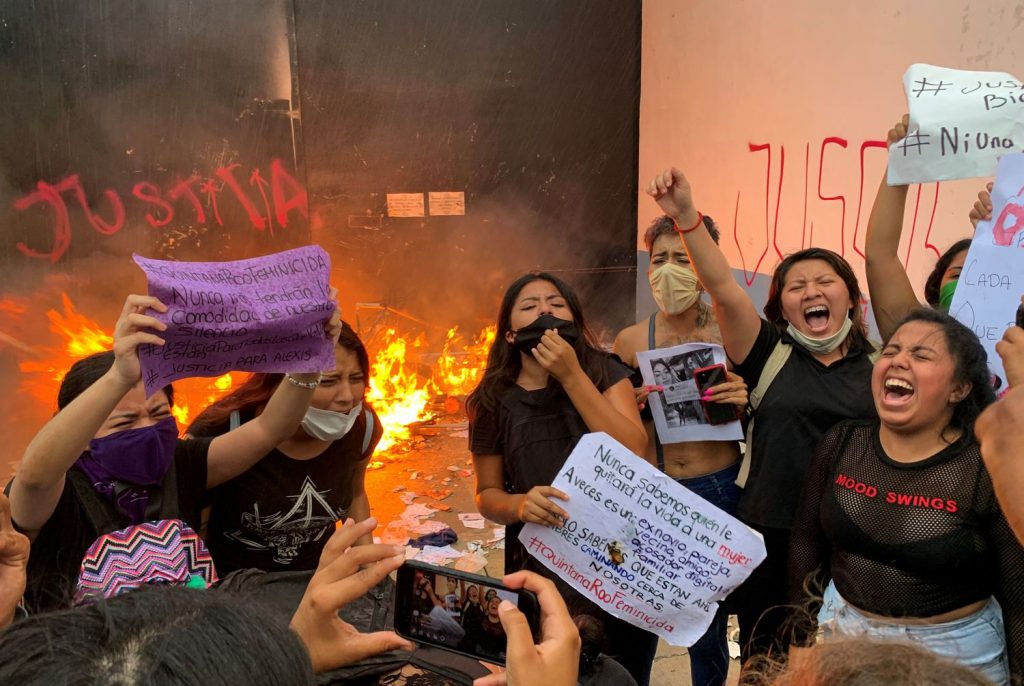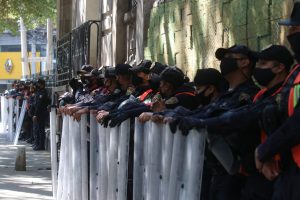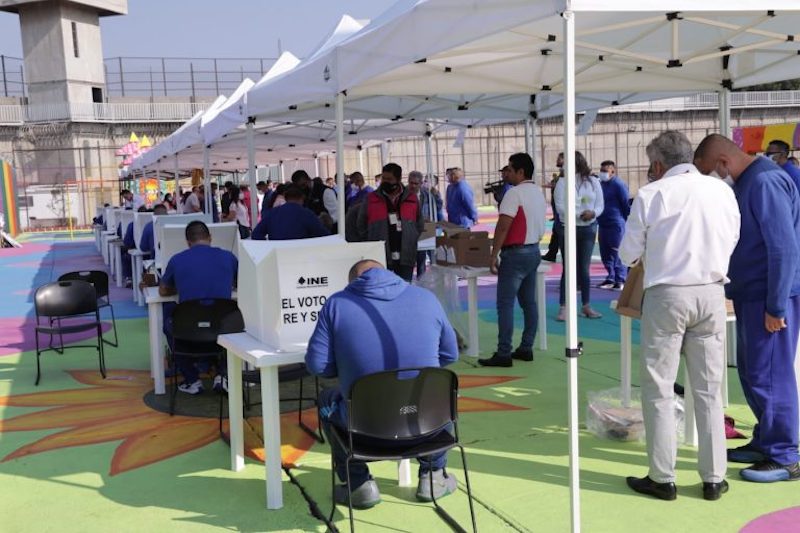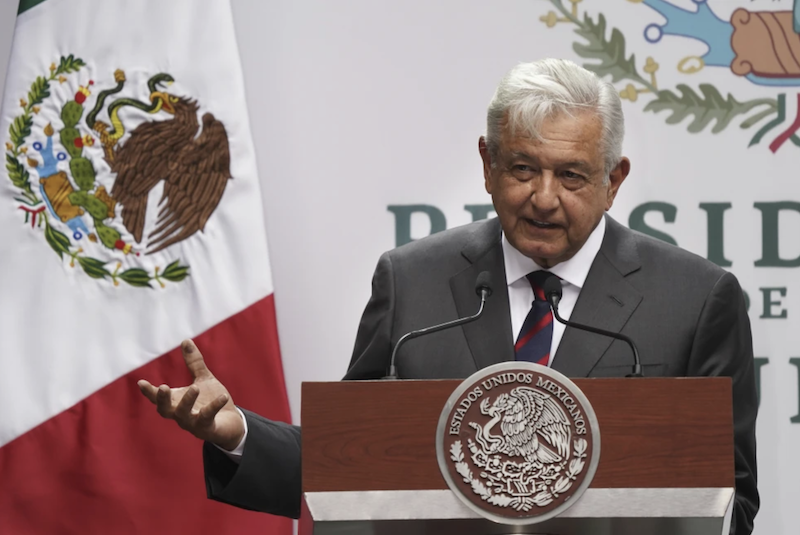Content warning: the following blog post contains mentions of sexual violence and assault
11/20/20 (written by vrice)— On November 9 at around 4:00pm, 2,000 protestors marched to the Quintana Roo Attorney General’s Office (Fiscalía Central), located in the city of Cancún. Demonstrators gathered to demand justice for Bianca Alejandrina Lorenzana Alvarado (“Alexis”) and implore the government to take more substantial action against femicide. The 20-year-old had gone missing on November 7, and her body was found two days later, dismembered in trash bags. The police of Benito Juárez, the municipality where Cancún is located, violently dispersed the protestors who had gathered. Four journalists were injured, two of which suffered bullet wounds, and two of the eight detained demonstrators reported sexual assault by the police. These acts are a reflection of a larger pattern of police repression of feminist protests and attacks on journalists in Mexico.

To Serve and Protect?
On the evening of November 9, 50 Benito Juárez police officers began firing on feminist protestors who attempted to break into the Attorney General’s Office. Following the event, the head of the police force, Eduardo Santamaría, was dismissed on grounds of “abuse of power” for ordering officers to fire on protesters. Santamaría argued that he had ordered officers to fire into the air, but demonstrators reported seeing police aim directly at protestors. Despite the otherwise peaceful nature of the protest, journalists Cecilia Solís (from the media outlet Energy FM) and Roberto Becerril (from The Truth News, La Verdad Noticias) suffered gunshot wounds in the leg and arm, respectively.
The Quintana Roo Attorney General’s Office falsely claimed no protestors had been detained via Twitter, despite reports from the Network of Quintana Roo Journalists (Red de Periodistas de Quintana Roo) that eight people had been detained a few hours prior. The Quintana Roo Human Rights Commission (La Comisión de los Derechos Humanos del Estado de Quintana Roo), whose personnel provided support to the detainees, corroborated the Network’s claims.
In addition to the police shootings, Animal Político reported that police used excessive force and sexually assaulted two peaceful demonstrators, María Elena and Quetzalli, after arresting them. María Elena also recounted seeing police aggressively beat a woman at the protest, even after she told them she was merely a journalist doing her job. Another journalist, Selene Hidrogo from Sipse TVCUN, cited how the police explicitly targeted reporters who attempted to record and broadcast the violence. Julián Ramírez, director of Cancún’s Kukulcán high school where he once had Alexis as a student, was detained at the protest and severely beaten by law enforcement. He shared that upon telling the police that Alexis was his student, the officers said they were going to “leave him worse off than her” (“me dijeron que me iban a dejar peor que ella”). After being released at 9:30pm the night of the protest, María Elena, Quetzalli, and Julián went to the State Human Rights Commission to file complaints.
The alleged abuses of power by the local police are in direct violation of the municipality’s law enforcement bylaws. Article 20, Sections V states that police must, “treat all persons with respect, abstaining from any arbitrary acts and from unduly limiting the public’s ability to carry out peaceful manifestations in exercise of their constitutional rights.” Additionally, Section VIII states that police must, “ensure the life and physical integrity of detained persons until the Public Ministry or a competent authority is available.” Given these clear legal violations, the actions of the Benito Juárez police have been met with widespread condemnation.
Will Chorus of Condemnations Translate Into Meaningful Action?
Hours before the protest, Mara Lezama, the Municipal President of Benito Juárez, tweeted, “Cancún is a city of liberties and rights, and because of this free, peaceful demonstrations will be protected.” After news of the shooting surfaced, Lezama tweeted again and released a video saying that she rebukes all acts of violence and that she had ordered an investigation into the “illegal and immoral” police actions. Carlos Joaquín González, Governor of Quintana Roo, also took to Twitter to clarify that he had given specific instructions that no aggression or weapons be used against protestors. The chorus of condemnations continued with Quintana Roo Chief of Police Alberto Capella, who deemed the police repression inacceptable and said that security camera footage would be reviewed to determine the perpetrators. Capella even resigned the next day in order to conduct an unbiased investigation. Gerardo Solis Barreto, the Secretary of the Benito Juárez City Council, also resigned in protest of the police’s actions, while also filing a complaint that police violated the Law on the Use of Force (Ley de Uso de la Fuerza).
At his daily morning press conference on November 10, President Andrés Manuel López Obrador (AMLO) said that an investigation must be conducted into what occurred in Cancún, and that those responsible must be punished. The President denied that the National Guard took part in the repression, which journalists present at the protest confirmed—with the caveat that the officers were bystanders during the abuses. AMLO said that if Governor Joaquín failed to carry out these investigations, then bodies like the National Commission on Human Rights (Comisión Nacional de los Derechos Humanos, CNDH) would have to intervene. For their part, the CNDH released a communication on November 10 rebuking the police repression. In it, the CNDH cited how the Inter-American Human Rights System (Sistema Interamericano de los Derechos Humanos) stipulates that in public demonstrations, state operatives must only use as little force as possible with the ends of protecting protestors. The Ministry of the Interior (Ministerio del Interior) and Mexican chapters of Amnesty International and United Nations Women echoed the condemnations.
Beyond digital denouncements, feminists in Mexico City (Ciudád de México, CDMX) organized a protest against femicide and the Benito Juárez police repression on November 11, outside of the Quintana Roo government office in the Colonia Roma district. City police surrounded the building with riot shields to prevent any attempted entry by demonstrators. Observers from the CDMX Human Rights Commission (Comisión de Derechos Humanos de la Ciudad de México, CDHCM) were in attendance to make sure no rights violations occurred.

The Larger Pattern of Oppression
Femicides and police violence against feminist protestors and journalists are part of a larger pattern in Quintana Roo and Mexico as a whole. In 2020, twelve femicides have already been registered in Quintana Roo. Moreover, Atizapán Municipal Police in the state of Mexico (Estado de México) violently attacked feminist demonstrators in September, while in Mexico City protestors marching for International Safe Abortion Day were teargassed and beaten. Just one day before the Cancún demonstration, Cuautitlán Municipal Police, also in the State of Mexico, tear gassed protestors. The demonstrators were demanding justice for the femicide of 17-year-old Ámbar Viridiana Uicab Tapia, who was found on November 6 in a sewage canal after having gone missing since October 23. These demonstrations in Atizapán and Cuautitlán are a product of the dangerous environment women face in the State of Mexico, which last year recorded the second highest number of femicide cases in the country. Mexico City also registered the greatest number of sex crimes of any city nationwide in 2019—accounting for nearly 13% of the national total for that year. Such violent police repression of feminist protests only seems to further impede women’s access to justice across Mexico.
Not only is Mexico one of the most dangerous countries for women, but it also consistently ranks amongst the most unsafe nations in the world for journalists. During 2019, the country recorded three times as many journalist murders than any other country worldwide. This threatening media climate is reflected in Mexico’s ranking of 143rd out of 180 countries on the 2020 World Press Freedom Index, even behind less democratic countries like Nicaragua (117th, rated “not free” at 31/100 by Freedom House), and South Sudan (138rd, rated “not free” at -2 by Freedom House). For reference, Freedom House has rated Mexico “partly free” with a score of 62/100. Moreover, over the last month, three journalists have been killed in Mexico: Arturo Alba (Ciudad Juárez), Jesús Alfonso Piñuelas (Sonora), and Israel Vazquez Rangel (Guanajuato).
Attacks on peaceful protestors and journalists like those in Cancún and across the State of Mexico, for example, undermine Mexicans’ constitutional rights—even more so when they come at the hands of the police. Damaging effects on citizens’ sense of trust and security are reflected in the 2020 Gallup Law and Order Index. Public opinion polls from the index display how Mexican citizens’ confidence in local police is the second lowest in all of Latin America. Venezuela, which is currently under the authoritarian dictatorship of Nicolás Maduro, was the only country where citizens exhibited lower confidence in local police than in Mexico.
Sources:
“Global Law and Order.” Gallup. 2020.
“Index Details: Data of press freedom ranking 2020.” Reporters Without Borders. 2020.
“Mexico.” Freedom House. 2020.
“Nicaragua.” Freedom House. 2020.
Ray, Julie. “Most of the World Remains Confident in Police, Feels Safe.” Gallup. October 27, 2020.
“South Sudan.” Freedom House. 2020.
“ONU Mujeres condena represión a protesta feminista en Cancún.” El Universal. November 10, 2020.
“Policías encapsulan a mujeres que protestan en CDMX contra feminicidios y represión en Cancún.” Animal Político, November 11, 2020.
Vega, Andrea. “Mujeres detenidas durante protesta en Cancún denuncian agresiones sexuales de los policías.” Animal Político. November 11, 2020.




